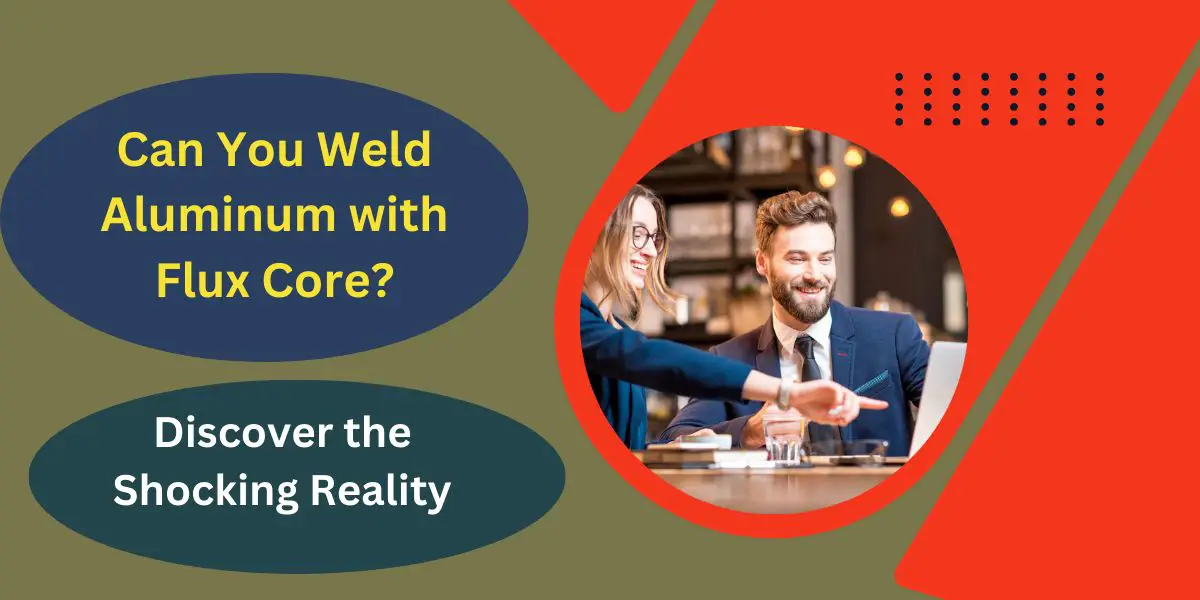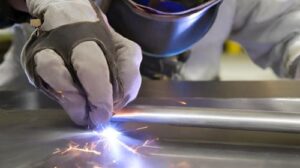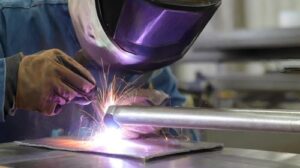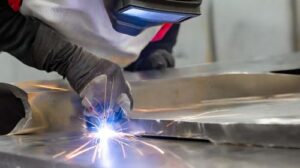Table of Contents
- How to Start Welding Aluminum with Flux Core
- Understanding the Flux Core Welding Process
- Can Aluminum Be Welded with Flux Core?
- Factors Affecting Aluminum Welding with Flux Core
- Tips for Successful Aluminum Welding Using Flux Core
- Comparing Flux Core Welding vs. Other Aluminum Welding Methods
- Advancements in Flux Core Aluminum Welding
- Safety Measures for Welding Aluminum with Flux Core
- Real-world Applications and Industries Using Aluminum Flux Core Welding
- Environmental Considerations in Aluminum Flux Core Welding
- Conclusion
- Future Trends in Aluminum Flux Core Welding
- FAQs: about Can You Weld Aluminum with Flux Core
Are you curious about welding aluminum with a flux core? Dive into our comprehensive guide to uncover the truth behind Can You Weld Aluminum with Flux Core. Discover techniques, challenges, and the potential of this innovative welding method.
How to Start Welding Aluminum with Flux Core
Welding aluminum poses unique challenges within metal fabrication due to its distinct properties. The process demands precision and specific techniques owing to aluminum’s low melting point and high thermal conductivity. In this context, flux core welding, a method known for its versatility and efficiency, prompts the question: Can You Weld Aluminum with Flux Core?
Understanding the Basics of Welding and Flux Core Process
At its core, welding involves joining two or more pieces of metal by melting and fusing them, creating a solid bond. Flux core welding, a subtype of arc welding, employs a continuous tubular wire filled with flux material. This flux acts as a shielding agent, preventing atmospheric contamination while the metal cools.
Specifics of Aluminum Welding
Aluminum presents distinct challenges due to its oxide layer, which forms almost instantly upon exposure to air. This oxide layer affects the weldability of aluminum, making it trickier to work with than other metals. The oxide layer impedes fusion, hampers electrical conductivity, and demands specialized attention during welding.
Flux Core Welding: Suitable for Various Materials
While flux core welding is commonly associated with steel welding, its adaptability extends to other materials, including aluminum. However, achieving successful results when welding aluminum with a flux core requires understanding the material’s properties and the adjustments needed to navigate its challenges.
Advantages and Limitations of Flux Core Welding
Flux core welding offers several advantages, such as high deposition rates, deep penetration capabilities, and suitability for outdoor applications due to its self-shielding nature. However, when it comes to welding aluminum, it encounters limitations due to the metal’s unique characteristics.
Challenges Faced in Aluminum Welding
Aluminum’s oxide layer, which protects the metal from corrosion, becomes a hurdle in welding. The oxide layer melts at a higher temperature than aluminum itself, making fusion difficult. Addressing this challenge becomes pivotal in successful aluminum welding with flux core.
Understanding the Flux Core Welding Process
Flux core welding is a dynamic process that relies on a tubular wire containing a flux core, offering distinct advantages in various welding applications. To comprehend its application in welding aluminum, it’s essential to delve deeper into the specifics of this welding technique.
Components of Flux Core Welding
The core components of flux core welding include a power source, a welding gun or torch, a continuous tubular wire electrode, and the flux core. This flux core, typically a combination of chemicals and powdered metals, shields the weld pool from atmospheric contaminants and facilitates smooth metal fusion.
Suitability for Various Materials
Flux core welding is renowned for its versatility and compatibility with various materials, including carbon steel, stainless steel, and some alloy metals. While initially designed for steel welding, technological advancements and flux formulations have expanded their potential for other metals, albeit with adjustments.
Advantages of Flux Core Welding
One of the primary advantages of flux core welding is its high deposition rate, allowing for faster welding speeds and increased productivity. Its ability to penetrate thicker materials and its self-shielding properties make it suitable for outdoor and windy conditions, where shielding gas in traditional welding methods might disperse.
Limitations and Challenges
However, flux core welding encounters specific limitations when applied to aluminum welding. The oxide layer inherent to aluminum poses challenges in achieving a clean weld. The flux, which works effectively in steel welding, struggles to penetrate the oxide layer, affecting the quality and integrity of the weld.
Techniques for Aluminum Welding with Flux Core
Aluminum welding with flux core demands specialized techniques to overcome the challenges posed by its oxide layer. Cleaning the surface to remove the oxide layer, adjusting welding parameters like wire speed and voltage, and employing suitable shielding gas is critical to achieving satisfactory welds.
Can Aluminum Be Welded with Flux Core?
The prospect of welding aluminum with flux core raises intriguing possibilities but also presents significant challenges due to the distinctive properties of this versatile metal. Exploring the feasibility of this welding process with aluminum necessitates a deeper examination of their compatibility and the techniques required for successful execution.
Characteristics of Aluminum Welding
Aluminum, known for its lightweight and corrosion-resistant properties, boasts a low melting point and high thermal conductivity. However, these traits that make aluminum desirable also render welding challenging. The formation of an oxide layer upon exposure to air poses a primary obstacle to achieving solid and clean welds.
Compatibility of Aluminum with Flux Core
Flux core welding, recognized for its efficiency in steel welding, encounters complexities when applied to aluminum due to the oxide layer. The flux, intended to shield the weld pool, struggles to penetrate the oxide layer, impeding the fusion process and affecting the overall weld quality.
Techniques for Successful Aluminum Welding
Successful aluminum welding with flux core demands precise techniques tailored to overcome the challenges posed by the oxide layer. Thorough surface preparation to eliminate the oxide layer, adjusting welding parameters such as wire speed and voltage, and employing suitable shielding gas configurations become imperative for achieving satisfactory welds.
Addressing Aluminum’s Oxide Layer
The oxide layer on aluminum, while protective, inhibits welding. Techniques involving aluminum-specific flux core wires or specialized flux formulations aim to counteract this challenge. These innovations enhance the flux’s ability to break through the oxide layer, facilitating cleaner welds.
Factors Affecting Aluminum Welding with Flux Core
Achieving successful aluminum welding with flux core involves navigating various factors that significantly influence the quality and integrity of the weld. Understanding these elements and their implications is pivotal in optimizing the welding process and obtaining satisfactory results.
Thickness of Aluminum
The thickness of the aluminum being welded plays a crucial role in determining the welding parameters and techniques required. Thinner aluminum sheets demand precise control over heat input to avoid burn-through, while thicker sections necessitate adjustments to achieve proper penetration without compromising structural integrity.
Flux Core Wire Selection
Selecting the appropriate flux core wire tailored for aluminum welding is imperative. Specialized wires designed explicitly for aluminum welding offer enhanced capabilities to break through the oxide layer and ensure better fusion. Factors like wire diameter, composition, and flux formulation contribute to the effectiveness of the welding process.
Shielding Gas Considerations
While flux core welding is often associated with self-shielding properties, aluminum welding may require additional shielding gas to improve the weld’s quality. Inert gases like argon or blends of argon and other gases can protect the weld from atmospheric contamination, which is especially crucial when dealing with the sensitive oxide layer on aluminum.
Adjusting Welding Parameters
Accurate adjustments to welding parameters such as wire speed, voltage, and current density are pivotal in achieving optimal results when welding aluminum with a flux core. Fine-tuning these settings ensures proper heat input and penetration while addressing the challenges posed by the oxide layer.
Techniques for Aluminum Welding
Employing specialized techniques like pulse welding or a push-pull torch system can enhance control and precision when welding aluminum with a flux core. These techniques facilitate better heat management and flux penetration, contributing to cleaner and stronger welds.
Tips for Successful Aluminum Welding Using Flux Core
Mastering aluminum with flux core welding involves implementing specific techniques and adhering to essential tips to overcome the challenges of aluminum’s unique properties. These tips ensure successful, high-quality welds using flux core welding techniques when working with aluminum.
Surface Preparation
Thorough surface preparation is fundamental in aluminum welding. Removing the oxide layer is critical for achieving clean and robust welds. Utilizing a stainless steel brush or dedicated aluminum cleaning solutions helps eliminate the oxide layer, preparing the surface for welding.
Adjusting Welding Settings
Fine-tuning welding settings is paramount in aluminum welding with flux core. Modifying wire speed, voltage, and amperage settings to suit the thickness and type of aluminum being welded ensures optimal heat input and penetration, mitigating issues related to the oxide layer and achieving better fusion.
Avoiding Common Mistakes
Understanding common mistakes in aluminum welding with flux core is crucial to prevent issues. Common errors include improper surface cleaning, incorrect welding settings, and inadequate shielding gas, which can compromise weld quality. Being aware of these pitfalls helps in avoiding them for better results.
Utilizing Aluminum-Specific Flux Core Wires
Employing flux core wires explicitly designed for welding aluminum significantly enhances the welding process. These specialized wires are formulated to break through the oxide layer more effectively, facilitating cleaner and stronger welds than standard flux core wires.
Controlling Heat Input
Aluminum’s susceptibility to heat makes controlling the heat input a critical aspect of successful welding. Minimizing heat input helps prevent burn-through in thinner sections and avoids distortion while ensuring adequate penetration in thicker aluminum.
Experimentation and Practice
Practice and experimentation are pivotal in mastering aluminum welding with flux core. Experimenting with different welding settings, techniques, and wire types allows welders to refine their skills and discover the most effective methods for specific aluminum welding applications.
Comparing Flux Core Welding vs. Other Aluminum Welding Methods
Understanding the strengths and limitations of flux core welding compared to other prevalent aluminum welding methods like TIG (Tungsten Inert Gas) and MIG (Metal Inert Gas) welding offers valuable insights into the nuances and suitability of each technique for welding aluminum.
TIG Welding for Aluminum
TIG welding is known for its precision and versatility, making it a preferred method for aluminum welding. This method utilizes a non-consumable tungsten electrode and a separate filler material if needed. TIG welding allows greater control over the welding process, producing clean, high-quality welds ideal for intricate aluminum joints.
MIG Welding for Aluminum
MIG welding, which uses a continuously fed wire as the electrode and a shielding gas, is widely used for aluminum welding. While MIG welding offers efficiency and ease of use, achieving optimal results in aluminum welding requires specific considerations, such as proper gas mixtures and wire types, to address the challenges posed by the oxide layer.
Flux Core Welding for Aluminum
Flux core welding, known for its high deposition rates and self-shielding properties, offers advantages in terms of efficiency and penetration, especially in outdoor or windy conditions. However, when applied to aluminum, flux core welding faces challenges penetrating the oxide layer, impacting weld quality compared to TIG and MIG welding.
Strengths of Flux Core Welding for Aluminum
Flux core welding excels in efficiency, high deposition rates, and suitability for outdoor applications. Its deep penetration capabilities make it valuable for thicker aluminum sections, providing faster welding speeds than other methods.
Limitations Compared to TIG and MIG Welding
When applied to aluminum, the challenges inherent in flux core welding lie in its struggle to break through the oxide layer effectively. This limitation affects the cleanliness and strength of the weld, often requiring meticulous surface preparation and specialized techniques to achieve satisfactory results compared to TIG and MIG welding.
Selecting the Right Method for the Job
Choosing the appropriate welding method for aluminum applications depends on various factors, including the project’s specifics, the desired weld quality, and the skill level of the welder. While TIG welding offers precision, flux core and MIG welding provide efficiency and productivity, albeit with considerations for aluminum’s unique challenges.
Advancements in Flux Core Aluminum Welding
The realm of flux-core aluminum welding continues to evolve, with ongoing innovations and advancements aiming to overcome the inherent challenges and improve the efficiency and quality of welding processes. These advancements are instrumental in pushing the boundaries of flux core welding and expanding its applicability in welding aluminum.
Innovations in Flux Core Wire
Continuous research and development efforts have led to innovations in flux core wires tailored explicitly for aluminum welding. These specialized wires undergo formulation enhancements to improve their ability to break through the oxide layer, resulting in cleaner and stronger welds.
Enhanced Techniques for Aluminum Welding
Refinements in welding techniques specific to aluminum, such as pulse welding or modified shielding gas compositions, contribute to better control and precision during welding. These advancements mitigate aluminum’s oxide layer’s challenges, aiming for higher-quality welds.
Future Prospects in Flux Core Aluminum Welding
The future of flux core aluminum welding appears promising, with ongoing research and technological advancements to refine the process further. Innovations focus on improving flux formulations, developing advanced welding equipment, and enhancing automation to streamline and optimize the welding process.
Addressing Specific Challenges
The primary challenge in flux core aluminum welding lies in effectively breaking through the oxide layer to ensure clean and robust welds. Advancements aim to tackle this challenge by devising improved flux compositions and innovative welding techniques explicitly tailored for aluminum applications.
Industry Impact and Applications
The advancements in flux core aluminum welding have substantial implications across various industries. Sectors such as automotive, aerospace, and marine industries benefit from these developments, leveraging aluminum’s lightweight and durable properties in their applications.
Safety Measures for Welding Aluminum with Flux Core
Ensuring safety is paramount in any welding process. Specific safety measures become crucial when working with aluminum using flux core welding techniques to protect the welder and the workplace environment.
Handling Aluminum Safely
Aluminum poses unique safety considerations due to its low melting point and high thermal conductivity. Ensuring proper handling practices, including using appropriate gloves and avoiding direct skin contact, reduces the risk of burns or injuries during preparation and welding.
Protective Gear for Welding
Utilizing adequate personal protective equipment (PPE) is essential. Welders should wear appropriate safety gear, including helmets with proper shade levels, flame-resistant clothing, welding gloves, and safety boots to shield against sparks, heat, and potential hazards.
Ventilation and Workspace Safety
Proper ventilation in the welding area is crucial, especially when working with aluminum. The welding process produces fumes and gases, and adequate ventilation helps prevent the accumulation of harmful airborne particles. Additionally, ensuring a clutter-free workspace minimizes tripping hazards and promotes a safe working environment.
Shielding from UV Radiation
Welding emits intense ultraviolet (UV) radiation, which can cause severe eye and skin damage. A welding helmet with the appropriate shade level protects the eyes from harmful UV rays. Protecting skin from exposure to UV radiation prevents burns and long-term health issues.
Education and Training
Proper education and training in aluminum welding safety practices are fundamental. Welders should be well-informed about the potential hazards associated with aluminum welding and trained in safety protocols, emergency procedures, and the use of safety equipment.
Regular Equipment Maintenance
Regular maintenance of welding equipment, including flux-core welding machines and ventilation systems, ensures optimal functionality. Faulty equipment can pose significant safety risks, so routine inspections and maintenance are crucial.
Real-world Applications and Industries Using Aluminum Flux Core Welding
The utilization of aluminum flux core welding extends across various industries, capitalizing on the unique properties of aluminum and the efficiency of flux core welding techniques. Understanding its applications provides insights into the diverse sectors benefiting from this welding method.
Automotive Industry Applications
Aluminum flux core welding finds extensive use in the automotive sector, particularly in the fabrication of vehicle components. Lightweight and durable aluminum components, welded efficiently using flux core techniques, contribute to enhanced fuel efficiency and structural integrity in vehicles.
Aerospace Industry Usage
The aerospace industry leverages aluminum flux core welding for manufacturing aircraft components and structures. The combination of aluminum’s lightweight properties and the efficiency of flux core welding ensures the construction of robust yet lightweight aerospace materials crucial for aircraft performance.
Marine Applications
In marine applications, aluminum flux core welding is pivotal in constructing vessels and marine structures. Aluminum’s resistance to corrosion, combined with the efficiency of flux core welding, results in durable and seaworthy structures, making it a preferred choice in marine fabrication.
Structural Fabrication
Aluminum flux core welding is also utilized in structural fabrication across various industries. The combination of aluminum’s strength and the productivity of flux core welding techniques enables the construction of sturdy and lightweight structures for architectural and industrial purposes.
Equipment Manufacturing
Manufacturing equipment and machinery often employ aluminum flux core welding for constructing specialized components. The versatility of aluminum, coupled with the efficiency of flux core welding, facilitates the production of reliable and high-performance machinery parts.
Environmental Considerations in Aluminum Flux Core Welding
The environmental impact of aluminum flux core welding is a significant aspect that necessitates attention and responsible practices. Understanding the ecological considerations associated with this welding process is crucial for promoting sustainability within the welding industry.
Impact on the Environment
Like other welding processes, aluminum flux core welding generates emissions and waste materials that can impact the environment. Emissions from welding fumes, gases, and waste materials like used consumables and packaging contribute to environmental pollution.
Recycling Aluminum
An essential aspect of mitigating the environmental impact involves recycling aluminum materials. Recycling aluminum reduces the need for extracting new aluminum, conserves energy, and minimizes greenhouse gas emissions associated with the extraction process, promoting a more sustainable approach.
Sustainable Practices in Welding
Implementing sustainable practices in aluminum flux core welding involves adopting environmentally friendly techniques and materials. This includes utilizing recycled aluminum whenever feasible, employing efficient ventilation systems to reduce emissions, and adhering to proper waste management practices.
Eco-friendly Welding Techniques
Innovations in welding technology aim to develop eco-friendly techniques that reduce environmental impact. Advancements in flux formulations, equipment efficiency, and process optimization contribute to minimizing waste generation and emissions during welding.
Promoting a Greener Approach
Promoting a greener approach in aluminum flux core welding involves raising awareness among welders and industries about the environmental impact of welding activities. Adopting sustainable practices and investing in eco-friendly technologies contributes to a more environmentally conscious welding industry.
Conclusion
The exploration of welding aluminum with flux core reveals the challenges and opportunities inherent in this welding technique. From understanding the complexities of aluminum welding to exploring the advancements in flux core technology, this comprehensive journey sheds light on the diverse aspects of this welding process.
Recap of Key Points
Throughout this exploration, key insights have emerged, emphasizing the unique challenges of aluminum’s properties, the efficiency of flux core welding, and the ongoing advancements in techniques and materials tailored for aluminum welding.
Summary of Advantages and Challenges
Aluminum flux core welding presents efficiency, productivity, and suitability advantages for various applications. However, challenges such as addressing the oxide layer and ensuring clean, strong welds remain pivotal in achieving successful outcomes.
Future Trends in Aluminum Flux Core Welding
The future of aluminum flux core welding appears promising, with ongoing innovations aiming to enhance flux formulations, refine welding techniques, and promote sustainability within the welding industry. These advancements pave the way for more efficient and environmentally conscious welding practices.
Embracing the Complexity
Welding aluminum with flux core requires a nuanced understanding of aluminum’s properties and careful navigation of its challenges. Embracing this complexity and employing specialized techniques and materials contribute to achieving high-quality welds in various applications.
Conclusion Remarks
In conclusion, the journey through welding aluminum with flux core showcases the intricate balance between technique, innovation, and the inherent characteristics of aluminum. As advancements continue to push the boundaries of welding technology, the prospects for efficient and effective aluminum welding with flux core remain bright.
FAQs: about Can You Weld Aluminum with Flux Core
Is flux core welding suitable for all aluminum thicknesses?
Flux core welding can be used with various aluminum thicknesses, but adjustments in settings and technique are necessary for optimal results.
What are the primary challenges of welding aluminum with flux core?
The primary challenge lies in addressing the oxide layer on aluminum, which affects the welding process and requires specific preparation and adjustments.
Can flux core welding replace other aluminum welding methods entirely?
While flux core welding offers advantages, it may not entirely replace other methods like TIG or MIG welding, as each has its strengths for different applications.
How does aluminum flux core welding impact the environment?
Aluminum flux core welding, like other welding processes, has environmental impacts, but adopting recycling and sustainable practices can mitigate these effects.




1 thought on “Can You Weld Aluminum with Flux Core? Explore Now!”